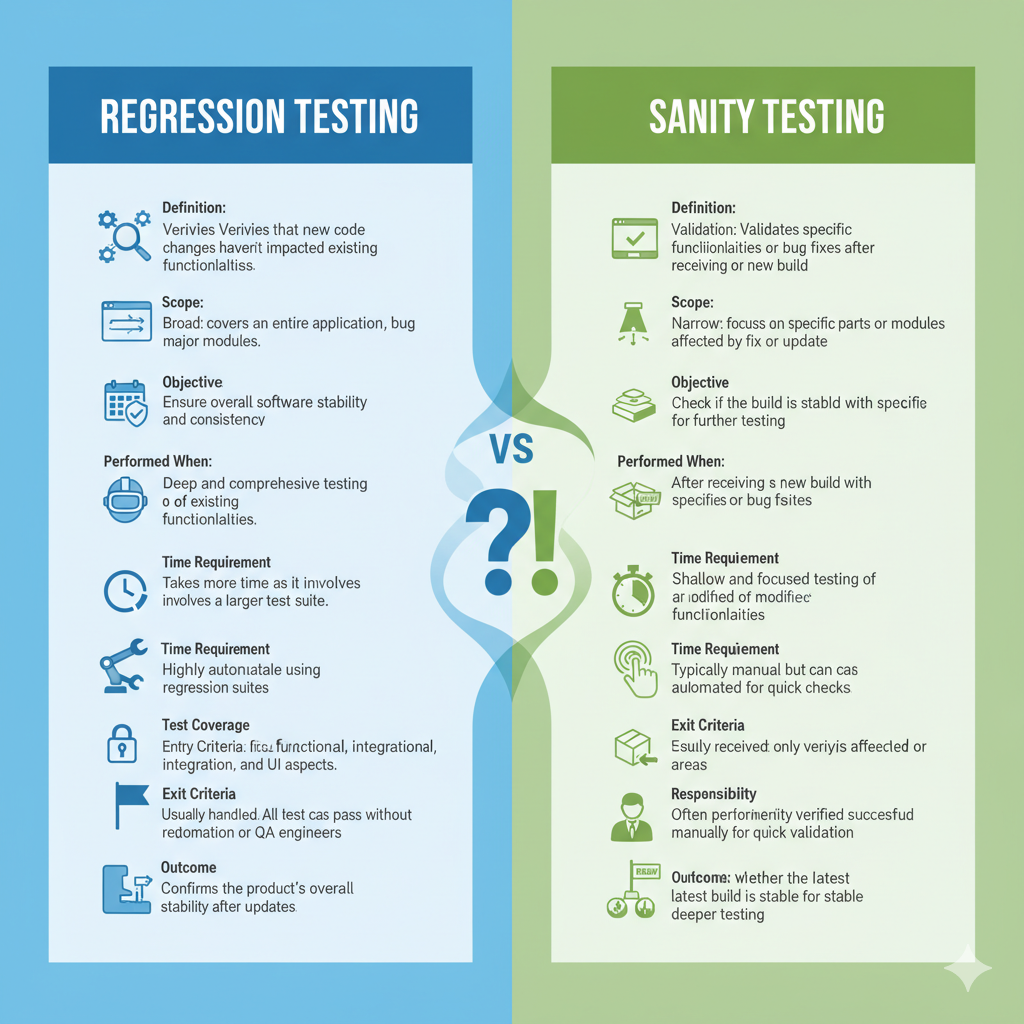Every tester knows the sinking feeling when a new code update breaks something that was perfectly fine before. That’s exactly where regression testing and sanity testing come in. While both aim to maintain product stability, their scope, timing, and intent differ significantly. Understanding these two testing types can help teams save time and ensure quality with confidence.
Regression testing is the process of re-running previously executed test cases to verify that new code changes haven’t unintentionally affected existing functionalities.
Table Of Contents
Example:
Let’s say you work on an e-commerce app and your team adds a “Wishlist” feature. Regression testing ensures that previously working features like the checkout flow, search, and payment gateway still function correctly after the update.
Purpose
The main purpose of regression testing is to ensure software stability after modifications. It verifies that bug fixes, enhancements, or code merges haven’t broken the system.
Key goals include:
- Detecting unintended side effects of new code changes
- Ensuring that older functionalities remain intact
- Maintaining overall software reliability across builds
Benefits
- Early Detection of Integration Issues: Catches problems before they impact production.
- Ensures Continuous Stability: Keeps the product consistent after every release.
- Supports Agile and CI/CD Workflows: Perfect for iterative development and frequent deployments.
- Improves User Experience: Prevents recurring defects in core functionalities.
Sanity Testing
Sanity testing is a quick check performed after receiving a new build or update to verify whether specific functionalities work as expected before proceeding with deeper testing.
Example:
Imagine you’re testing a banking app where developers fix a bug in the “Funds Transfer” module. Before running a full test suite, you perform sanity testing to ensure the bug is actually fixed and related core functions (like account balance updates) work fine.
Purpose
The primary purpose of sanity testing is to validate small sections of functionality after changes or fixes. It acts as a checkpoint before more comprehensive testing.
Key goals include:
- Confirming that the reported issues are fixed
- Verifying that no major components are broken after the fix
- Deciding whether the build is stable enough for further testing
Benefits
- Saves Time: Prevents teams from testing unstable builds.
- Quick Validation: Helps confirm whether the fix works correctly.
- Improves Efficiency: Allows teams to focus on relevant test areas.
- Acts as a Gatekeeper: Ensures only valid builds move to deeper regression or functional testing.
Regression Testing Vs Sanity Testing: What’s the Difference?

| Aspect | Regression Testing | Sanity Testing |
| Definition | Verifies that new code changes haven’t impacted existing functionalities. | Validates specific functionalities or bug fixes after receiving a new build. |
| Scope | Broad: covers the entire application or major modules. | Narrow: focuses on specific parts or modules affected by a fix or update. |
| Objective | Ensure overall software stability and consistency. | Check if the build is stable enough for further testing. |
| Performed When | After code enhancements, bug fixes, or updates. | After receiving a new build with specific changes or bug fixes. |
| Depth of Testing | Deep and comprehensive testing of existing functionalities. | Shallow and focused testing of modified functionalities. |
| Time Requirement | Takes more time as it involves a larger test suite. | Takes less time as it targets specific functionalities. |
| Automation Feasibility | Highly automatable using regression suites. | Typically manual but can be automated for quick checks. |
| Test Coverage | Extensive: includes functional, integration, and UI aspects. | Limited: only verifies affected areas. |
| Entry Criteria | Stable build after code changes. | Newly received build after bug fixes or updates. |
| Exit Criteria | All test cases pass without regression defects. | Core functionality verified successfully for further testing. |
| Responsibility | Usually handled by automation or QA engineers. | Often performed manually by testers for quick validation. |
| Outcome | Confirms the product’s overall stability after updates. | Confirms whether the latest build is stable for deeper testing. |
Advantages & Limitations of Regression Testing
Advantages
- Ensures that existing functionality remains unaffected after updates
- Reduces production defects through continuous validation
- Supports test automation for faster releases
- Strengthens confidence before product deployment
Limitations
- Time-consuming without automation support
- Can become complex with large applications
- Requires frequent test case maintenance
- High resource utilization during execution
Advantages & Limitations of Sanity Testing
Advantages
- Quick and efficient in verifying small changes
- Prevents wasting time on unstable builds
- Helps detect major showstopper issues early
- Enables faster feedback to developers
Limitations
- Limited test coverage
- Largely manual and non-scripted
- Not suitable for detailed regression validation
- Doesn’t guarantee overall system stability
Why Perform Regression and Sanity Testing in Testsigma?
Testsigma is an Agentic AI-powered codeless test automation platform that allows teams to effortlessly create, execute, and manage test cases across web, mobile, API, Salesforce, and SAP applications. It streamlines both regression and sanity testing, enabling testers to quickly validate new features or fixes while ensuring existing functionality remains intact.
Key Features That Make Regression and Sanity Testing Effortless in Testsigma:
- Codeless Test Creation: Build regression and sanity tests in plain language like English, without writing code. You can also use the Generator Agent to automatically generate test cases from Jira tickets, Figma designs, screenshots, images, videos, PDFs, and other files.
- Reusable Test Steps: Share and reuse common test steps across multiple builds, minimizing duplication and speeding up test creation.
- Parallel Execution: Execute regression and sanity tests simultaneously on 3000+ devices and browsers, ensuring broad coverage and faster detection of issues.
- CI/CD Integration: Automatically trigger regression and sanity tests with every new build, providing instant feedback and preventing defects from progressing downstream.
- Self-Healing Test Maintenance: Detect and automatically fix broken test steps caused by minor UI changes, reducing maintenance effort and keeping tests reliable over time.
- Detailed Reporting and Logs: Access clear, actionable insights into test failures, helping teams quickly determine whether an issue is isolated or affects core functionality.
Conclusion
The main difference between regression testing and sanity testing lies in their scope and intent. Regression testing ensures the entire system remains stable after changes, while sanity testing verifies that recent fixes or updates work correctly.
Both regression and sanity testing can be efficiently performed in Testsigma, where AI agents help automate and accelerate each stage of the testing process. You can start exploring these capabilities with a free trial today.
FAQs
Regression testing ensures that existing functionalities remain unaffected after changes, while sanity testing quickly verifies that specific new features or bug fixes work correctly.
No, regression testing does not include sanity testing, as it focuses on verifying existing functionalities rather than quickly validating specific new changes or fixes.
You should prioritize sanity testing when a new build has minor changes or bug fixes and you need a quick check before performing deeper testing.
No. Both regression and sanity testing can be automated or manual, depending on the tools and processes used.
They ensure that new changes work correctly (sanity testing) while confirming that existing functionalities remain stable (regression testing), reducing the risk of defects in production.
If sanity testing passes but regression testing fails, the new fixes work, but other parts of the system are broken. If regression testing passes but sanity testing fails, existing functionalities are stable, but the new changes or fixes are not working correctly.


